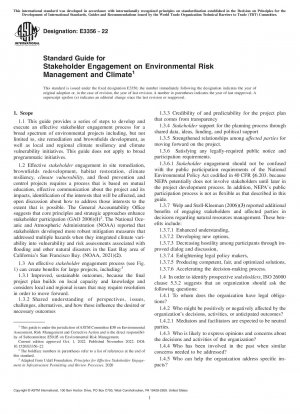ASTM E3356-22
Standard Guide for Stakeholder Engagement on Environmental Risk Management and Climate
- Standard No.
- ASTM E3356-22
- Release Date
- 2022
- Published By
- American Society for Testing and Materials (ASTM)
- Latest
- ASTM E3356-22
- Scope
- 1.1 This guide provides a series of steps to develop and execute an effective stakeholder engagement process for a broad spectrum of environmental projects including, but not limited to, site remediation and brownfields development, as well as local and regional climate resiliency and climate vulnerability initiatives. This guide does not apply to broad programmatic initiatives. 1.2 Effective stakeholder engagement in site remediation, brownfields redevelopment, habitat restoration, climate resiliency, climate vulnerability, and flood prevention and control projects requires a process that is based on mutual education, effective communication about the project and its impacts, identification of the interests that will be affected, and open discussion about how to address those interests to the extent that is possible. The General Accountability Office suggests that core principles and strategic approaches enhance stakeholder participation (GAO 2006)(1)2 . The National Oceanic and Atmospheric Administration (NOAA) reported that stakeholders developed more robust mitigation measures that addressed multiple hazards when they integrated climate variability into vulnerability and risk assessments associated with flooding and other natural disasters in the East Bay area of California’s San Francisco Bay. (NOAA, 2021)(2). 1.3 An effective stakeholder engagement process (see Fig. 1) can create benefits for large projects, including:3 1.3.1 Improved, sustainable outcomes, because the final project plan builds on local capacity and knowledge and considers local and regional issues that may require resolution in order to move forward. 1.3.2 Shared understanding of perspectives, issues, challenges, alternatives, and how these influence the desired or necessary outcomes 1.3.3 Credibility of and predictability for the project plan that comes from transparency 1.3.4 Stakeholder support for the planning process through shared data, ideas, funding, and political support 1.3.5 Strengthened relationships among affected parties for moving forward on the project. 1.3.6 Satisfying any legally-required public notice and participation requirements. 1.3.6.1 Stakeholder engagement should not be confused with the public participation requirements of the National Environmental Policy Act codified in 40 CFR §6.203. because NEPA potentially does not involve stakeholders until later in the project development process. In addition, NEPA’s public participation process is not as flexible as that described in this guide. 1.3.7 Welp and Stoll-Kleeman (2006)(3) reported additional benefits of engaging stakeholders and affected parties in decisions regarding natural resources management. These benefits include: 1.3.7.1 Enhanced understanding, 1.3.7.2 Developing new options, 1.3.7.3 Decreasing hostility among participants through improved dialog and discussion, 1.3.7.4 Enlightening legal policy makers, 1.3.7.5 Producing competent, fair, and optimized solutions, 1.3.7.6 Accelerating the decision-making process. 1.4 In order to identify prospective stakeholders, ISO 26000 clause 5.3.2 suggests that an organization should ask the following questions: 1.4.1 To whom does the organization have legal obligations? 1.4.2 Who might be positively or negatively affected by the organization’s decisions, activities, or anticipated outcomes? 1.4.2.1 Mediators and facilitators are expected to be neutral parties. 1.4.3 Who is likely to express opinions and concerns about the decisions and activities of the organization? 1.4.4 Who has been involved in the past when similar concerns needed to be addressed? 1.4.5 Who can help the organization address specific impacts? 1 This guide is under the jurisdiction of ASTM Committee E50 on Environmental Assessment, Risk Management and Corrective Action and is the direct responsibility of Subcommittee E50.05 on Environmental Risk Management. Current edition approved Oct. 1, 2022. Published November 2022. DOI: 10.1520/E3356–22 2 The boldface numbers in parentheses refer to a list of references at the end of this standard. 3 Adapted from Udall Foundation. Principles for Effective Stakeholder Engagement in Infrastructure Permitting and Review Processes. 2020 Copyright © ASTM International, 100 Barr Harbor Drive, PO Box C700, West Conshohocken, PA 19428-2959. United States This international standard was developed in accordance with internationally recognized principles on standardization established in the Decision on Principles for the Development of International Standards, Guides and Recommendations issued by the World Trade Organization Technical Barriers to Trade (TBT) Committee. 1 1.4.6 Who can affect the organization’s ability to meet its responsibilities? 1.4.7 Who are the affected parties that would be disadvantaged if excluded from the engagement? 1.5 Stakeholder prioritization criteria 1.5.1 Identification of criteria to prioritize stakeholder engagement may be useful for some projects (Sharpe, 2021)(4). These criteria include, but are not limited to: 1.5.1.1 Level of interest, 1.5.1.2 Proximity, including nearby property owners,, 1.5.1.3 Fairness, 1.5.1.4 Magnitude of impact, 1.5.1.5 Underrepresented and underserved populations, 1.5.1.6 Probability of impact, 1.5.1.7 Level of community influence, 1.5.1.8 Cost, and 1.5.1.9 Time to implement a proposed project plan. 1.6 This international standard was developed in accordance with internationally recognized principles on standardization established in the Decision on Principles for the Development of International Standards, Guides and Recommendations issued by the World Trade Organization Technical Barriers to Trade (TBT) Committee.
ASTM E3356-22 Referenced Document
- ASTM E2348 Standard Guide for Framework for a Consensus-based Environmental Decision-making Process*, 2024-02-01 Update
- ISO 26000:2010 Guidance on social responsibility
ASTM E3356-22 history
- 2022 ASTM E3356-22 Standard Guide for Stakeholder Engagement on Environmental Risk Management and Climate
